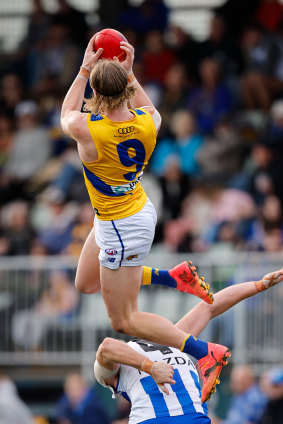Opinion
Why the AFL draft needs an overhaul to a two-tier system
Michael Gleeson
Sports columnistBefore they find out their ATAR scores, hundreds of young footballers’ futures will already be decided.
The AFL’s national draft in November will decide the immediate futures of these schoolboys who are barely men.
Barely 18, they will attend, or log in to, a national draft at which dreams will either be realised or dashed, bags packed for cross-country flights or cross-city drives, or, more commonly, thrown against a wall in despair.

Jason Horne-Francis and Nick Daicos have stamped their class on the AFL in their first three years.Credit: Stephen Kiprillis
If lucky enough to be chosen in the draft, they will enter an AFL industry of acute pressure. The demand to perform is urgent, the analysis of individual sporting performance granular, the intensity of social media attention sudden and unsparing.
Overwhelmingly, the teenagers arriving in the system are not physically, emotionally or mentally ready for the pervasive intensity of the game. Many 18-year-olds struggle with the change from school routines to university or work, let alone a professional football environment.
The mental health problems of footballers are real and now well-known.
AFL chief executive Andrew Dillon wrote in his foreword to the AFL Industry Mental Health and Wellbeing Strategy for 2024-27: “Mental health remains the number one issue of importance for our players”.
And yet kids enter a system, get paid a relatively large amount of money, suddenly find themselves minor celebrities whose work performances are also scrutinised and as an industry, we wonder why they have high levels of mental health problems.
There is a persuasive argument to lift the draft age by at least by a year, but preferably two, to 20.

No.1 pick Harley Reid had an outstanding first year in the AFL. Credit: AFL Photos via Getty Images
The standard argument against a rise in the draft age is that it punishes the precocious. Nick Daicos, Will Ashcroft and Harley Reid are rare talents who step straight out of school onto the MCG and perform from day one. Why should they have to wait? One reason is that in all things, these players are the exceptions to the norm.
An option that conceptually appeals to senior AFL people – albeit without a timeframe or agenda for immediate change – is to push the draft age back to 19 or 20 for all bar the first round of players.
So an elite 18-year-old could still be drafted in his first year, but only if his name is called out in the first round. After that, the player returns to state or other leagues where they play and develop for a year or two until they turn 20 and can be taken in any round.
The average AFL player’s career is less than six years. But that is an average; the later you are drafted, the shorter your career.
Statistics provided by the AFL show that players drafted in the first round are on an AFL list for 9.7 years and play 132 games on average. That is about two years and 40 games more than players taken in the second round. And the numbers scale down by each round, which is to be expected – the better players are taken earlier and therefore play for longer.
But a two-tier draft, which would allow for 18-year-olds to be immediately drafted in the first round, then only 20-year-olds and older after that, has merit.
Firstly, players would come into the system more emotionally and physically ready for the game in its multi-faceted way.
Those players would have two years of study or work experience, so theoretically at least would be more mature and grounded. Their two years of a university course, apprenticeship or other work experience would be an advantage for the inevitable transition out of football.
The players would play state league football with the hope of being drafted, which would have a twin effect. It would heighten interest in the second-tier competitions as football fans more keenly observe which players might be available to them in the draft. And recruiters would be less likely to have as many misses with players because they have a bigger body of work to assess them from.
The national draft and player exchange industry, which tries to generate hype around the drafting of schoolboy footballers the overwhelming number of fans have never seen or heard of, would have more than confected interest in it. Like the NFL draft, which the AFL has long tried to replicate, the next generation of players would be better-known to the football public, as the college players in their early 20s are in the NFL.
Far from hurting players such as Isaac Smith, Tom Stewart or Brody Mihocek, a delayed start to their careers arguably made them better players.
The AFL is interested in the idea in principle and keen to consider options to improve the draft system and the mental wellbeing of players, but with the imminent arrival of a Tasmania team that will dilute the draft pool and a CBA still running, no change such as this is imminent.
It would mean a hiatus period only for a year or two until the first tranche of players arrived as first-time draftees at 20 in the second and later rounds, then the same flow of players would remain.
Tasmania and the complexities of change shouldn’t be seen as impediments. They should be viewed as welcome opportunities to offer time to hasten slowly. There is time now to properly craft a new and better system that does not pluck unready kids out of their homes, send them across the country to an abnormal world of outsized expectations to perform immediately and then wonder why players don’t succeed at a better rate and why so many struggle with mental health problems.
Keep up to date with the best AFL coverage in the country. Sign up for the Real Footy newsletter.